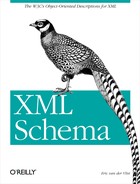Name
xs:element(global definition) — Global element definition that can be referenced within the same schema by other schemas.
Synopsis
<xs:element
abstract = xs:boolean : “false”
block = ( “#all” | list of ( “extension” | “restriction” |
“substitution” ) )
default = xs:string
final = ( “#all” | list of ( “extension” | “restriction” ) )
fixed = xs:string
id = xs:ID
name = xs:NCName
nillable = xs:boolean : “false”
substitutionGroup = xs:QName
type = xs:QName
{any attributes with non-schema namespace}
>
Content: (xs:annotation?, (xs:simpleType | xs:complexType)?, (xs:unique |
xs:key | xs:keyref)*)
</xs:element>
May be included in: xs:schema
Description
All the elements defined at the top level of a schema (i.e.,
xs:element, which is included directly under the
xs:schema document element) are considered
globally defined.
Globally defined elements have a global scope: they can be referenced through their qualified name everywhere in the schema in which they are defined, as well as in any schema that imports or includes this schema. They can also be used as document elements in instance documents.
Elements are identified by their qualified name, but the local name
is expected in the name attribute. The type
definition is performed by assigning a simple or complex datatype to
the element.
This assignment can be done either by reference, using the
type attribute to refer to a simple or complex
datatype by its qualified name, or inline, by embedding the
definition of the simple (xs:simpleType) element
or the complex (xs:complexType) element that is
within the xs:element element.
A default value may be defined using the default
attribute, but note that the semantics of default values for elements
are different than those of the default values for attributes. An
element is not created if it is absent from the instance document;
the default value is applied only if the element is present and
empty.
Several control attributes are included in element definitions (see
the attributes abstract,
blocked, final,
fixed, and nillable) .
Element definitions are also the place in which substitution groups
are defined using the substitutionGroup attribute
to refer to the head of the substitution group. Any global element
that is not final may be chosen as the head of a
substitution group. Any reference to the head of a substitution group
may be replaced in the instance documents by any of the members of
the substitution group (assuming these substitutions have not been
blocked through block attributes). The relation is
transitive, and if the head of a substitution
“A” is a member of another
substitution group “B,” the members
of “A” are also considered members
of “B.”
Restrictions
There is no feature that allows definition of global elements that cannot be used as document elements. When this is needed, the workaround is to define all the elements, save one, and use simple and complex types or element groups instead of global elements to define reusable content models, and then reference these types from a single globally-defined element.
The identification of the global elements by their qualified names makes it impossible to globally define multiple elements that have the same qualified name. When a schema must include multiple definitions of elements that have the same qualified name (and different datatypes), all the definitions except one must be locally declared. It is possible to use simple and complex types or element groups instead of global elements to define reusable content models.
All globally defined elements must be qualified if a target namespace has been defined for the schema; they must all belong to the target namespace. When no target namespace is defined, all the elements that are globally or locally defined must be unqualified.
The default and fixed values are defined in attributes and, therefore, can only apply to simple type elements.
Elements cannot be directly redefined. To redefine an element, one can either include it in a group and redefine the group, or use a global complex type to define the element and redefine the complex type.
Attributes
-
abstract Controls whether the element may be used directly in instance documents. When set to
true, the element may still be used to define content models, but it must be substituted through a substitution group in the instance document.-
block Controls whether the element can be subject to a type or substitution group substitution.
#allblocks any substitution,substitutionblocks any substitution through substitution groups, andextensionandrestrictionblock any substitution (both throughxsi:typeand substitution groups) by elements or types, derived respectively by extension or restriction from the type of the element. Its default value is defined by theblockDefaultattribute of the parentxs:schema.-
default Default value of the element. Defined in an attribute, element default values must be simple contents. Also note that default values apply only to elements that are present in the document and empty. The
fixedanddefaultattributes are mutually exclusive.-
final Controls whether the element can be used as the head of a substitution group for elements whose types are derived by extension or restriction from the type of the element. Its default value is defined by the
finalDefaultattribute of the parentxs:schema.-
fixed A simple content element may be fixed to a specific value using this attribute. This value is also used as a default value, and if the element is empty, it is supplied to the application. The
fixedanddefaultattributes are mutually exclusive.-
id W3C XML Schema’s element ID.
-
name Local name of the element (without namespace prefix).
-
nillable When this attribute is set to
true, the element can be declared as nil using anxsi:nilattribute in the instance documents.-
substitutionGroup Qualified name of the head of the substitution group to which this element belongs.
-
type Qualified name of a simple or complex type (must be omitted when a simple or complex type definition is embedded).
